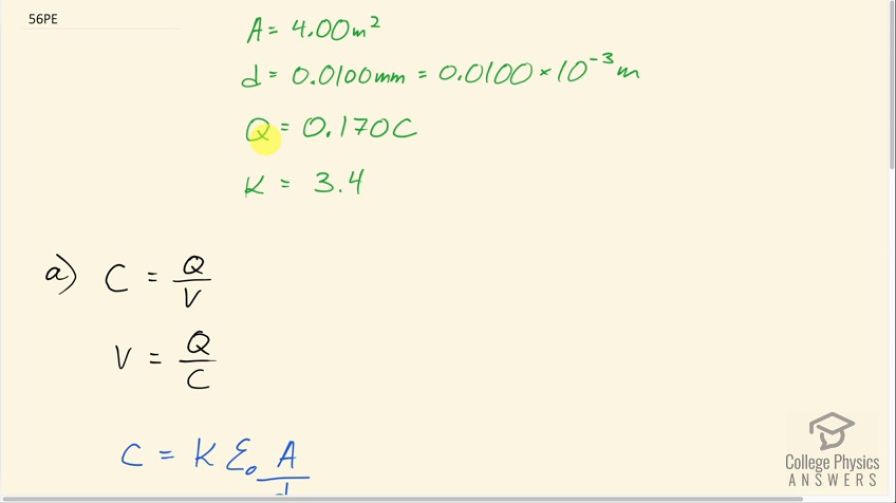Question
(a) A certain parallel plate capacitor has plates of area , separated by 0.0100 mm of nylon, and stores 0.170 C of charge. What is the applied voltage? (b) What is unreasonable about this result? (c) Which assumptions are responsible or inconsistent?
Final Answer
- The electric field is 100 times the maximum possible for nylon. The nylon will conduct, thereby reducing the electric field, before reaching such a high electric field.
- The charge of 0.170 C is unreasonably high.
Solution video
OpenStax College Physics for AP® Courses, Chapter 19, Problem 56 (Problems & Exercises)

vote with a rating of
votes with an average rating of
.
Video Transcript
This is College Physics Answers with Shaun Dychko. A parallel-plate capacitor with an area of 4.00 square meters and a separation between plates of 0.0100 millimeters is assumed to have a charge on it of 0.170 coulombs and there's 'nylon' as a material between the plates and the dielectric constant of nylon is 3.4. So the capacitance is charger per voltage and our question is what is the voltage on this capacitor? So we multiply both sides by V over C and then we solve for V then and it equals the charge divided by the capacitance but we need to use this formula for the parallel-plate capacitor and that is the dielectric constant multiplied by the permittivity of free space multiplied by the area of the plates divided by the separation between them. And so we will substitute this in for C in this formula for V and when we are dividing by a fraction, we'll multiply by its reciprocal instead so we are multiplying by d over Kε 0 times A. So we have 0.170 coulombs times 0.0100 times 10 to the minus 3 meters—separation— divided by dielectric constant of 3.4 multiplied by the permittivity of free space times the area of 4.00 square meters and that gives 14.1 kilovolts. Now this voltage is too high given such a small separation between the plates because we can calculate the electric field that would result and that is the voltage divided by the distance between these parallel plates. So that's 14.124 times 10 to the 3 volts divided by 0.0100 times 10 to the minus 3 meters which is 1.41 times 10 to the 9 volts per meter. But if we look up in this data table here [19.1], the dielectric strength—in volts per meter— for nylon is 14 times 10 to the 6 and so this electric field that we have calculated here is 100 times the maximum that's possible and so this electric field is way too strong and once you get above this maximum, the dielectric breakdown occurs, in which case, the dielectric material does conduct electricity and so the electric field can't get any stronger than this because the conduction will cause the charge on the two plates to diminish since, you know, the negative charges from one plate are going to neutralizing the positive charges on the other so the field can't get any higher than this. And so it's unreasonable to think that 0.170 coulombs of charge are actually on the plates.